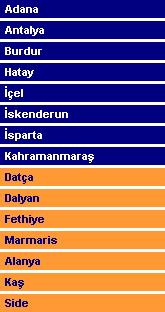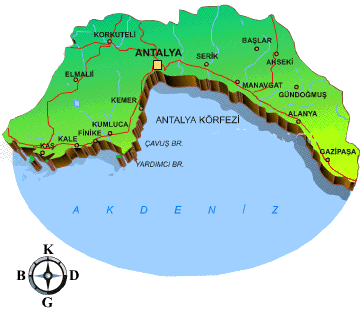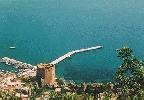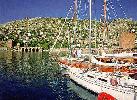| Alanya... |
|
In 1220 the Seljuk sultan Alaeddin Keykubad I took the city and had the great castle and dockyards built. Known then as
Alaiye, a name derived from that of the sultan, the city was used by the Seljuks as their naval base in the Mediterranean
and it remained an important military post in Ottoman times. A century later the Arab traveller Ibn Battuta visited Alanya
and described it thus: The city of Alaiye is a large town on the seacoast. It is inhabited by Turkomans and is visited by
the merchants of Cairo, Alexandria, and Syria. The district is well-wooded and wood is exported from there to Alexandria
and Damietta, whence it is carried to the other cities of Egypt. There is a magnificent and formidable citadel, built by
Sultan Alaeddin at the upper end of the town. The "magnificent and formidable citadel" was built by Alaeddin
Keykubad I in 1226 on the site of an earlier fortress. (Strabo refers to one being here in Roman times.) It consists of
three sections: an inner keep, the central castle, and an external redoubt. The inner keep contains cisterns, the ruins
of a Seljuk palace, a fresco-decorated courtyard, military fortifications, and a Byzantine chapel in the middle. At the
northwestern corner is a place where prisoners condemned to death were hurled over the precipice by means of catapults.
The central castle contains a masjid built in 1230 by Aksebe Sultan as well as her tomb. Süleymaniye Mosque was originally
constructed in 1231 but was rebuilt during the reign of Süleyman the Magnificent when an Ottoman arasta (row of shops) was
added. There is also a 17th century Ottoman khan. Located on the outer walls of the castle is Kizil Kule (Red
Tower), so called because of the red bricks used in its construction. This octagonal structure was built in 1227 and stands
in all its magnificence even today. (It is particularly impressive when illuminated at night.) Adjacent to the tower are
the dockyards where five vessels could be worked on at a time. Next to the dockyards is a tower called Tophane Kule (Arsenal
Tower) where cannons were cast during Ottoman times. Nearby close to the seashore is a cave called Damlatas. The humid air
inside this cave is supposed to be good for those suffering from asthmatic problems. Alanya's archaeological museum contains
numerous interesting works and is well worth a visit. Owing to its vital importance as a naval base, Alanya was connected
by roads that went east and west and into the hinterland. (The Seljuk capital was up country in Konya).
|
|

|








